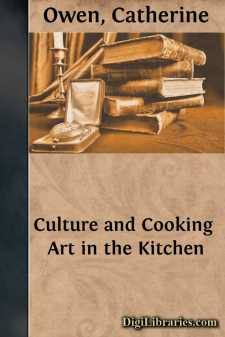Categories
- Antiques & Collectibles 13
- Architecture 36
- Art 48
- Bibles 22
- Biography & Autobiography 813
- Body, Mind & Spirit 142
- Business & Economics 28
- Children's Books 15
- Children's Fiction 12
- Computers 4
- Cooking 94
- Crafts & Hobbies 4
- Drama 346
- Education 46
- Family & Relationships 57
- Fiction 11828
- Games 19
- Gardening 17
- Health & Fitness 34
- History 1377
- House & Home 1
- Humor 147
- Juvenile Fiction 1873
- Juvenile Nonfiction 202
- Language Arts & Disciplines 88
- Law 16
- Literary Collections 686
- Literary Criticism 179
- Mathematics 13
- Medical 41
- Music 40
- Nature 179
- Non-Classifiable 1768
- Performing Arts 7
- Periodicals 1453
- Philosophy 64
- Photography 2
- Poetry 896
- Political Science 203
- Psychology 42
- Reference 154
- Religion 513
- Science 126
- Self-Help 84
- Social Science 81
- Sports & Recreation 34
- Study Aids 3
- Technology & Engineering 59
- Transportation 23
- Travel 463
- True Crime 29
The Healthy Life Cook Book, 2d ed.
by: Florence Daniel
Categories:
Description:
Excerpt
I.—UNFERMENTED BREAD.
1. COLD WATER BREAD.
1-1/4 lb. fine wholemeal flour to 3/4 pint water.
Put the meal into a basin, add the water gradually, and mix with a clean, cool hand. (Bread, pastry, etc., mixed with a spoon, especially of metal, will not be so light as that mixed with a light cool hand.) Knead lightly for 20 minutes. (A little more flour may be required while kneading, as some brands of meal do not absorb so much water as others, but do not add more than is absolutely necessary to prevent the fingers sticking.) Put the dough on to a floured board and divide into four round loaves. Prick with a fork on top.
The colder the water used, the lighter the bread, and if the mixing be done by an open window so much the better, for unfermented bread is air-raised. Distilled or clean boiled rain-water makes the lightest bread. But it should be poured backwards and forwards from one jug to another several times, in order to aerate it.
Another method of mixing is the following:—Put the water into the basin first and stir the meal quickly into it with a spatula or wooden spoon. When it gets too stiff to be stirred, add the rest of the meal. Knead for two minutes, and shape into loaves as above.
BAKING.—Bake on the bare oven shelf, floored. If possible have a few holes bored in the shelf. This is not absolutely necessary, but any tinker or ironmonger will perforate your shelf for a few pence. Better still are wire shelves, like sieves. (This does not apply to gas ovens.)
Start with a hot oven, but not too hot. To test, sprinkle a teaspoonful of flour in a patty pan, and put in the oven for five minutes. At the end of that time, if the flour is a light golden-brown colour, the oven is right. Now put in the bread and keep the heat of the oven well up for half an hour. At the end of this time turn the loaves. Now bake for another hour, but do not make up the fire again. Let the oven get slightly cooler. The same result may perhaps be obtained by moving to a cooler shelf. It all depends on the oven. But always start with a hot oven, and after the first half hour let the oven get cooler.
Always remember, that the larger the loaves the slower must be the baking, otherwise they will be overdone on the outside and underdone in the middle.
Do not open the oven door oftener than absolutely necessary.
If a gas oven is used the bread must be baked on a baking sheet placed on a sand tin. A sand tin is the ordinary square or oblong baking tin, generally supplied with gas stoves, filled with silver sand. A baking sheet is simply a piece of sheet-iron, a size smaller than the oven shelves, so that the heat may pass up and round it. Any ironmonger will cut one to size for a few pence. Do not forget to place a vessel of water (hot) in the bottom of the oven. This is always necessary in a gas oven when baking bread, cakes or pastry.
It must not be forgotten that ovens are like children they need understanding. The temperature of the kitchen and the oven's nearness to a window or door will often make a difference of five or ten minutes in the time needed for baking....













